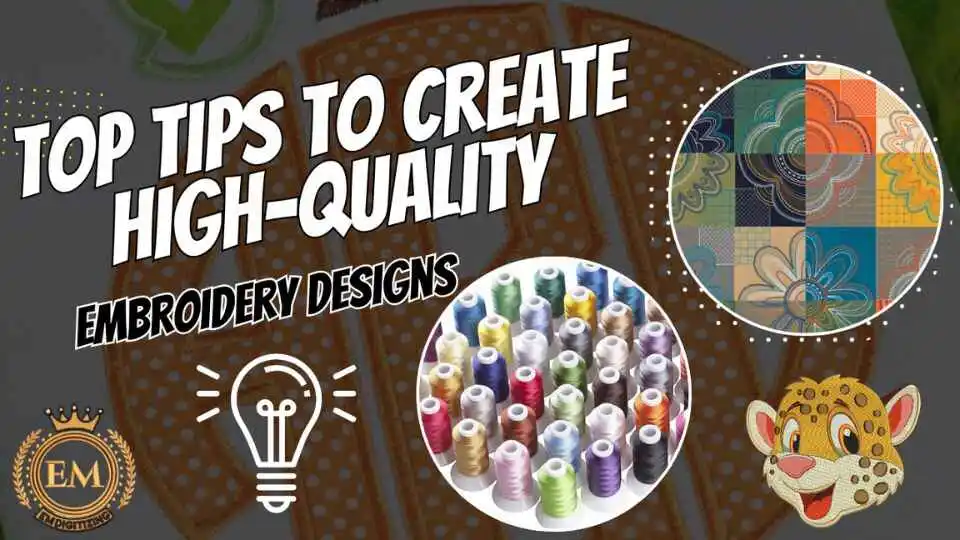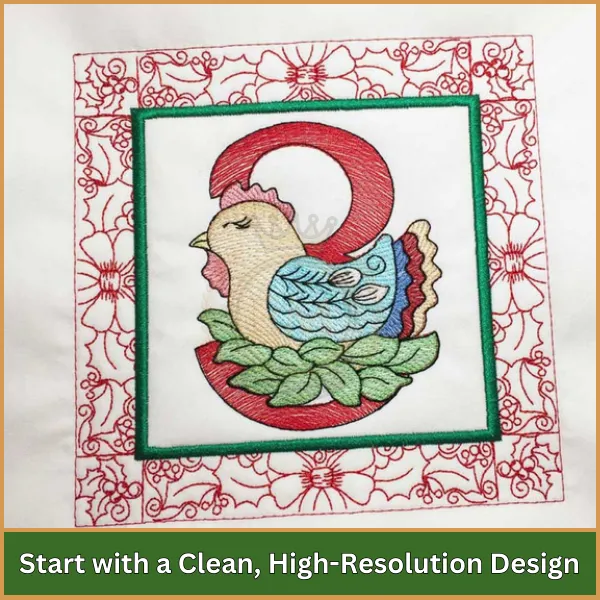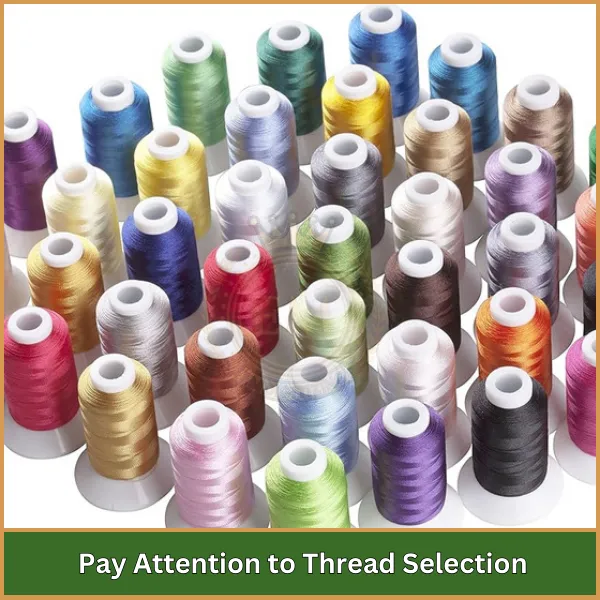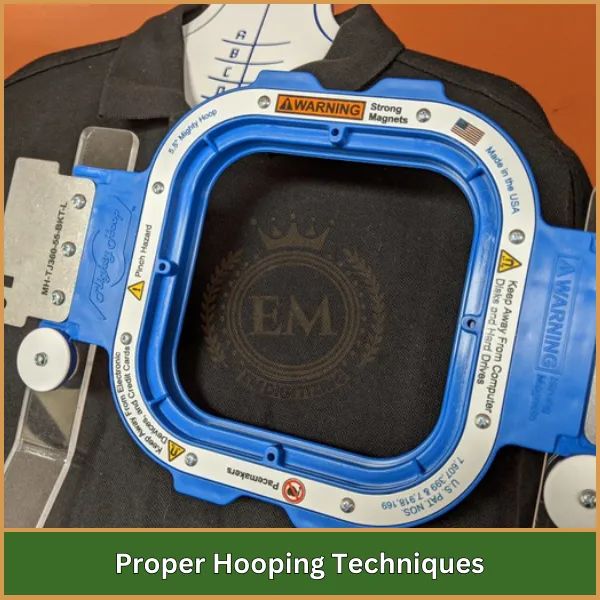Creazione ricami di alta qualità riguarda le tecniche giuste e l'attenzione ai dettagli. Scegliendo i migliori materiali, Usando semplici trucchi, e pianificare attentamente il tuo design, Puoi ottenere risultati professionali che si distinguono.

Con un po 'di pratica e la giusta guida, Anche i disegni complessi possono sembrare puliti e belli. Ogni passo conta, Dalla selezione dei colori al perfezionamento dei punti.
Esploriamo 17 Suggerimenti per i ricami professionali per aiutarti a creare un magnifico design da ricamo:
- Scegli il software di ricamo giusto
- Usa i formati di file corretti
- Inizia con un pulito, Design ad alta risoluzione
- Seleziona il tessuto giusto per il tuo design
- Presta attenzione alla selezione dei thread
- Ottimizza il tuo design per cuciture
- Tecniche di cerchio adeguate
- Testa il tuo design con una corsa di esempio
- Mantieni e calibra il tuo Macchina da ricamo
- Collaborare con un servizio di digitalizzazione professionale
Suggerimenti migliori per creare design di ricami di alta qualità
1. Scegli il software di ricamo giusto
Il diritto software di ricamo è essenziale per creare progetti di qualità professionale. Il software avanzato offre strumenti come Stitch Simulation, ridimensionamento, e editing, che ti aiutano a personalizzare i tuoi progetti alla perfezione.
Programmi come Wilcom, Schiudere, e il fratello PE-Design è popolare per la loro facilità d'uso e caratteristiche potenti. Cerca un software di progettazione da ricamo che supporti più formati di file e fornisca tutorial per aiutare i principianti a iniziare. Investire in software di alta qualità garantisce un migliore controllo sui progetti e minimizza gli errori durante le cuciture.
2. Usa i formati di file corretti
L'uso del formato file corretto è essenziale per la creazione ricami di alta qualità. Le macchine da ricamo funzionano con formati specifici, come l'ora legale, PES, JEF, ed ESP, con DST è uno dei più popolari.
Always check your machine’;S compatibilità prima di salvare il design. Molti programmi software per ricami offrono una facile conversione tra i formati, permettendoti di adattare i tuoi progetti per diverse macchine. La formattazione corretta del file garantisce i punti di progettazione senza intoppi e come previsto, evitare errori o problemi.
3. Inizia con un pulito, Design ad alta risoluzione

La chiarezza del tuo disegno del ricamo dipende fortemente dalla qualità dell'immagine originale.
Inizia sempre con un'immagine ad alta risoluzione, Poiché le immagini di bassa qualità possono provocare ricami distorti o pixelati.
Semplifica il design rimuovendo i dettagli inutili che potrebbero non tradurre bene in punti.
Concentrati su linee pulite e forme audaci per i migliori risultati. Regola le dimensioni del design per adattarsi al tessuto mantenendo la sua chiarezza, Poiché i progetti troppo complessi possono perdere il loro fascino.
4. Seleziona il tessuto giusto per il tuo design
La selezione del tessuto è fondamentale per raggiungere ricami di alta qualità. Ogni tipo di tessuto interagisce in modo diverso con i punti, so it’;è importante abbinare il tuo design con il materiale giusto. Tessuti robusti come cotone, tela, o il denim è eccellente per i design dettagliati, mentre tengono i punti saldamente senza distorsione.
Tessuti elastici come la maglia, però, richiedono stabilizzatori per impedire di arricchire e mantenere la chiarezza del design. Evita di usare tessuti troppo delicati o eccessivamente spessi, poiché possono essere impegnativi per la tua macchina da gestire in modo efficace.
5. Presta attenzione alla selezione dei thread

Il tipo e la qualità del filo che usi possono influire significativamente sul risultato del tuo ricamo.
I fili di poliestere sono resistenti e a colori, rendendoli ideali per la maggior parte dei progetti. Fili di rayon, noto per la loro lucentezza, sono fantastici per i design decorativi.
Assicurati che il colore del filo completa il design e il tessuto. I fili di alta qualità riducono le possibilità di rottura e sfilacciamento durante le cuciture, con conseguente ricamo più fluido.
Inoltre, Abbina sempre il peso del filo ai requisiti del progetto e prova su un campione di tessuto per garantire i migliori risultati.
Una corretta selezione del thread migliora l'aspetto generale e la durata dei tuoi progetti.
6. Ottimizza il tuo design per cuciture
Ottimizzare correttamente il design assicura che si limiti perfettamente. Ciò include la regolazione della densità del punto, impostazioni del sottopunto, e riducendo le sovrapposizioni eccessive. Troppi punti in una piccola area possono causare arricciatura, Mentre troppo pochi possono lasciare lacune.
Le cuciture sottostanti forniscono una base stabile, Garantire che il design appaia pulito e professionale. Metti alla prova il tuo design su tessuto simile per garantire che tutti gli elementi siano allineati e ottimizzati.
7. Tecniche di cerchio adeguate

Sicuro e persino il cerchio è vitale per raggiungere disegni di ricami di alta qualità.
Assicurarsi che il tessuto sia strettamente tesso senza rughe, Poiché il tessuto sciolto può portare a disallineamento o increspatura.
L'uso degli stabilizzatori giusti per il tessuto aggiunge il supporto necessario per mantenere la precisione.
Per materiali difficili, I cerchi magnetici o le clip possono essere un'ottima soluzione, Mantenere il tessuto stabile e garantire che il design rimanga coerente durante il processo di cucitura.
Controlla sempre la tensione del cerchio prima di iniziare a evitare di spostarsi durante le cuciture e per garantire un impeccabile, finitura professionale.
8. Testa il tuo design con una corsa di esempio
L'esecuzione di un punto di prova su tessuto simile è un passaggio fondamentale per garantire che il tuo design funzioni come previsto. Una corsa di esempio ti aiuta a identificare potenziali problemi come i problemi di tensione dei thread, disallineamento, o problemi di densità del punto. Il test consente di apportare le regolazioni necessarie prima di lavorare sul tessuto finale, risparmiando tempo e prevenire i materiali sprecati.
9. Mantieni e calibra la tua macchina da ricamo
Una manutenzione adeguata è una delle punte dei ricami a macchina più cruciali per garantire un funzionamento regolare e cuciture di alta qualità. Pulisci regolarmente l'area della bobina, Rimuovere la lanugine, e olio la macchina secondo le istruzioni del produttore.
Assicurarsi che la tensione del thread sia corretta, E usa sempre un ago affilato che corrisponda al tipo di tessuto. Calibrazione, come allineare l'ago e il cerchio, Aiuta a mantenere la precisione ed evita errori durante il processo di ricamo. Prendersi cura della macchina garantisce coerente, Risultati professionali ogni volta.
10. Collaborare con un servizio di digitalizzazione professionale
Gestire progetti di ricamo personalizzati intricati o complessi può essere impegnativo, Ma un servizio di digitalizzazione professionale come EMDigitalizzazione può semplificare il processo. Si specializzano nella conversione dei disegni in formati compatibili con la macchina con configurazioni di punti precisi.
Con esperienza nella densità del punto, sottosopra, e ottimizzazione del design, Emdigitizzare assicura che i tuoi progetti di ricamo ottengano risultati impeccabili. Fare affidamento su un servizio professionale non solo risparmia il tempo, ma garantisce anche risultati di alta qualità, in particolare per progetti dettagliati o sfusi.
Conclusione
La creazione di design di ricami di alta qualità non deve essere difficile. Con le giuste consigli e tecniche di progettazione da ricamo, Puoi realizzare disegni che sembrano puliti, professionale, e si distingue.
All'EMDigitizing, Siamo qui per supportare il tuo viaggio di ricamo. Forniamo servizi di digitalizzazione professionale ai prezzi più convenienti, con tempi di inversione di tendenza e qualità garantita.
Più, Se ci stai provando per la prima volta, avrai un'esclusiva 50% spento il tuo primo ordine. Non perdere clicca qui per iniziare e dare vita ai tuoi design di ricamo!
Domande frequenti
Il tessuto giusto dipende dal design e dal tipo di progetto. I tessuti stabili come il cotone o il denim sono ottimi per i design dettagliati, mentre i tessuti elastici possono richiedere stabilizzatori per prevenire la distorsione.
La digitalizzazione garantisce che il design sia pronto per il ricamo a macchine convertendolo in istruzioni precise del punto. Questo passaggio è cruciale per mantenere l'accuratezza e ottenere un risultato lucido.
Non tutti i tessuti sono adatti per ricami dettagliati. I tessuti spessi e robusti maneggiano meglio disegni intricati, Mentre i tessuti sottili o delicati possono lottare con dettagli fini.
Software da ricamo come Wilcom, Brillantezza, o Hatch è l'ideale per creare e personalizzare i progetti. Questi strumenti offrono funzionalità avanzate per migliorare i modelli e migliorare la qualità del punto.
